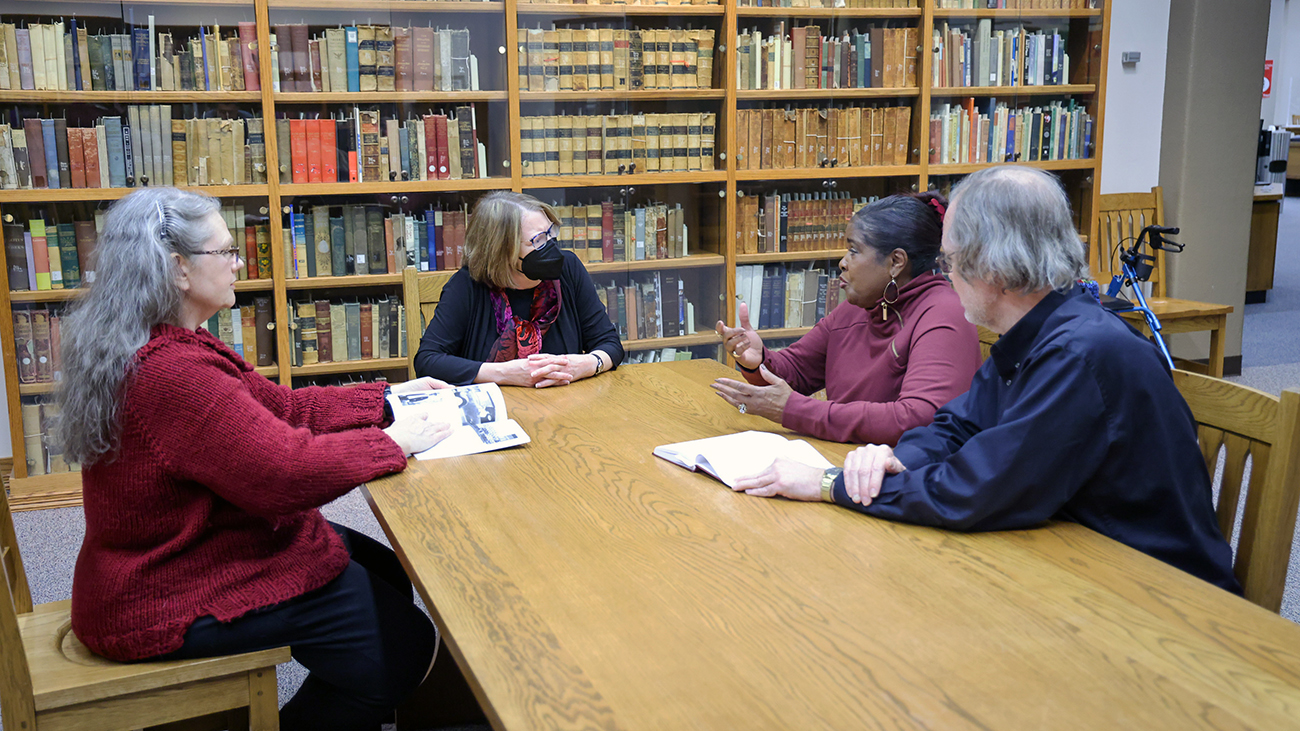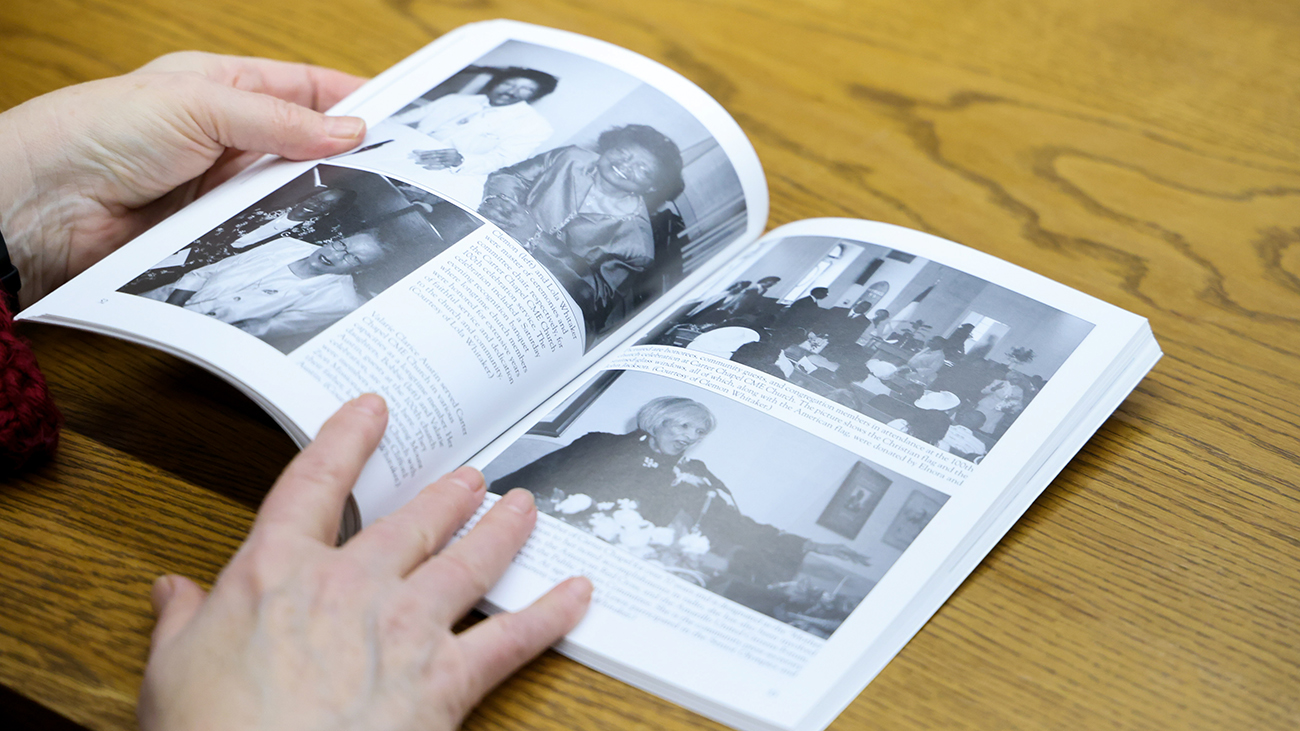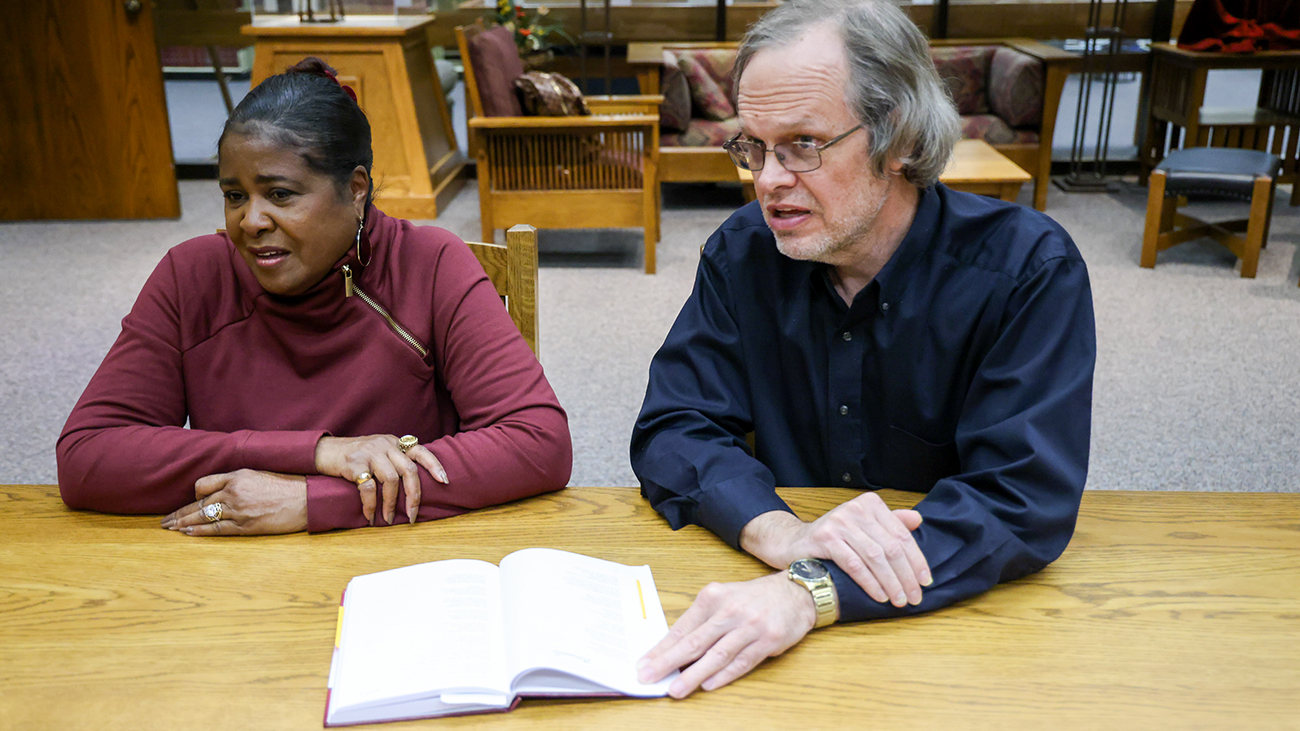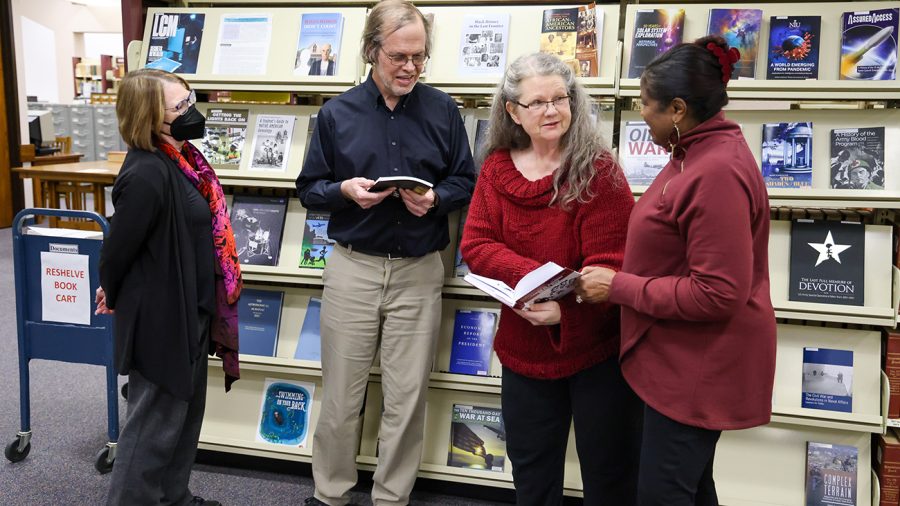Jon Mark Beilue: A history of race in one place
African American history of WT, Amarillo found with one click
About four years ago, some West Texas A&M University history students were in the government documents section of the Cornette Library doing research. One student was looking for background on Ruby Lewis, aka “Lady Cool Breeze,” the first African American disc jockey and the first female disc jockey in the Texas Panhandle.
Carolyn Ottoson, the government documents librarian, showed the student some techniques on research and demonstrated the database WorldCat, an online catalog of books and other resources in libraries worldwide. They found a record of a VHS videotape of a roundtable discussion with Lewis and 14 other African-Americans in Amarillo. It was taped at the North branch of the Amarillo Public Library and stored at the Amarillo Public Library.
It delighted Ottoson, but at the same time concerned her.
“It was the only copy that seemed available in any library in the world,” Ottoson said. “It chilled me that time and technology could cause the voices on the video to become lost.”
“Reflections of the Past: A History of North Amarillo” was a roundtable discussion at the North branch library on Feb. 20, 2000. Fifteen Black, longtime Amarillo residents reminisced about the North Heights community, families, experiences, leaders and landmarks. Some spoke of segregation and discrimination. Some did not.
 Photo: Dr. Jean Stuntz, from left, Carolyn Ottoson, Claudia Stuart and Dr. Marty Kuhlman discuss their efforts to chronicle and make available the history of Black residents in the Amarillo area.
Photo: Dr. Jean Stuntz, from left, Carolyn Ottoson, Claudia Stuart and Dr. Marty Kuhlman discuss their efforts to chronicle and make available the history of Black residents in the Amarillo area.
Among those sharing their thoughts on the 90-minute video were Helen Neal, WT’s first Black graduate; Lewis; the Rev. Jesse Cortez; and Charles Warford, founder of Warford-Walker Mortuary who the Amarillo chapter of the NAACP honored with a lifetime achievement award.
This was local living history, voices that would one day be gone. Ottoson needed some assurance that a video like this needed would not be lost.
“This was too important to disappear,” she said. “I had to do something.”
Ottoson reached out to colleagues at the Amarillo Public Library, which had ownership of the aging videotape. She was given permission to produce additional copies, though there were problems transitioning from VHS to DVD.
“The VHS quality was not good,” Ottoson said. “It was 15 years old by that point. It was fuzzy. People were not using a microphone when talking. It looked to be shot on a professional tripod, but it was obviously not in a studio.”
Digitizing the video was the best option. A copy of the video is stored in the WT DSpace Repository and available to the public at wtamu-ir.tdl.org/handle/11310/4140.
Ottoson took it a step further. In the roundtable discussion, it’s not always clear who is speaking and what is said among the group. It was a tedious task, but Ottoson put together a transcript by listening to and noting who was speaking many times over. Photographs and timestamps were added to help navigate the video.
“I was afraid someone doing research would have to give up on the interviews because they wouldn’t have time to go through everything,” she said. “It’s not an official transcript and the text may not be 100 percent accurate and complete, but it’s a guide and I hope valuable.”
60 different works compiled
Ottoson then took another step by compiling a list of books, articles, papers and dissertations on African-American history in Amarillo in general and newspaper articles specifically about roundtable participants. By the time she was finished, more than 60 different works were compiled, also available on the WT DSpace Repository.
Bruce Todd’s 2005 book “Bones Hooks, Pioneer Negro Cowboy” tells the story of the man who founded the region’s first black church and established North Heights. Todd also wrote “Anchors and Pillars,” a brief oral history about early black settlers in Amarillo that began with Jerry Calloway arriving in 1888.
 Photo: Dr. Jean Stuntz pages through “African-Americans in Amarillo,” which she cowrote with Claudia Stuart.
Photo: Dr. Jean Stuntz pages through “African-Americans in Amarillo,” which she cowrote with Claudia Stuart.
“African-Americans in Amarillo” is a book co-authored by retired WT faculty Claudia Stuart and Dr. Jean Stuntz. Stuart was a sociology and criminal justice professor and was WT’s first full-time African American woman professor in 1996. Stuntz was a history professor at WT for 21 years, retiring last May.
“The most apparent thing to me,” Stuart said, “was how each and every one that were leaders in their community were humbled by their experiences and the fact that people held them is so high esteem.
“The community (North Heights) was very close-knit. They were left to their own resources. The community was self-sustaining and people took care of each other.”
Churches, in particular, Mt. Zion Baptist Church and Johnson Chapel A.M.E. Church, were a beacon for families and a lighthouse for growth in North Amarillo.
“A lot of authority was heaped upon them by the congregation,” said Stuart, named a WT Distinguished Alumna in 2021. “Pastors had an inside knowledge of what a family’s needs were and helped get those needs met. People instrumental in the church were your community heroes.”
In the fight for integration and equality in Amarillo, some of those North Heights bonds may have been broken by necessary progress.
“Of the people I talked to, I would say not every change is good, or completely good,” Stuntz said. “They had fought so hard to integrate and be accepted by the white community that one of the things that happened is that North Heights started to deteriorate a little bit.
“A lot of folks didn’t go to school together any more. They were mixed with everyone else. There was a sense of loss in the community. Now some of that might be nostalgia, but what they described was a North Heights before integration that was a very thriving community with a lot of professionals and the churches were really strong. It sounded like a refuge from the outside world.”
WT’s first African-American students were in 1960
 Photo: Claudia Stuart and Dr. Marty Kuhlman chat in West Texas A&M University’s Cornette Library, which has compiled a resource guide for people researching Black life in Amarillo.
Photo: Claudia Stuart and Dr. Marty Kuhlman chat in West Texas A&M University’s Cornette Library, which has compiled a resource guide for people researching Black life in Amarillo.
Also included in Ottoson’s collection is Dr. Marty Kuhlman’s 5,900-word paper for the Panhandle-Plains Historical Review on the integration of colleges in Texas with the major focus on then-West Texas State College. Kuhlman is WT’s Jenny Lind Porter Professor of History, and much of his teachings are on the Civil War, Reconstruction and the civil rights movement.
Integration at WT, like all public universities in Texas, came in fits and starts in the 1950s. There was not the violence as in the Deep South, but obstacles were more the culture, the courts and views on race that had been shaped and handed down since the United States was founded.
A judge struck down a segregation law within the University of Texas system in 1954 that prevented blacks from attending one of the system universities. That prompted an editorial from The Canyon News, a pro-segregation newspaper.
“We are happy indeed that Canyon does not have a Negro population. … Soon the bars will be down in all colleges of Texas and Negroes will be admitted. If more was done to strengthen Negro colleges, there would not be a call for integration.”
Guy Tomlin, 57, an instructor at Amarillo Air Force Base, was the first African-American to apply to attend WT in 1956. He was not successful.
Matthew Shipp, a graduate of Carver High School in Amarillo, twice applied to attend WT in 1958 and 1959. After he was denied a second time, a petition was filed on his behalf for enrollment by the Texas chapter of the NAACP. Thurgood Marshall, NAACP national counsel and later the first African-American justice on the Supreme Court, was one of those who signed the petition.
Federal Judge Joe B. Dooley ruled in favor of Shipp on Feb. 11, 1960. Because the semester had already started, Shipp pursued his education downstate. In the fall semester of 1960, Betty Jo Thomas of Wichita Falls, and Carver graduates Mae Deane Franklin and Roy Watson were the first blacks to enroll at WT.
Helen Neal enrolled in the spring of 1961, and she was the first African-American to graduate from WT when she received her degree in secondary education in August 1962. She was an Amarillo teacher for the next 20 years.
“Football pushed WT toward a more liberal spirit and then eased the transition of integration after court-ordered desegregation,” Kuhlman wrote.
Head coach Joe Kerbel, hired in 1960, was color-blind. All he wanted to do was win, and the skin color that helped him do that didn’t matter. If that rankled some fans, he didn’t care. WT was ahead of virtually all the state’s public universities in integrating the football team.
Pete Pedro of Lynn, Mass., was among the first African-American players in 1961. He would go down as one of WT’s most explosive backs in history.
In an era where the first Southwest Conference team to have a black player was in 1966, and the Texas Longhorns were the last all-white team to win a national title in 1969, WT had 10 blacks on the team in 1965, including quarterback Hank Washington. Future NFL running backs Mercury Morris in 1967-68 and Duane Thomas in 1968-1970 continued to break color barriers.
All of those who are the focus of the printed word and video in Ottoson’s collection were at times victims of cruel Jim Crow laws and debilitating segregation. Warford tells of his single mom forced to pay taxes to Amarillo College, a school her children could not attend. He served his country in World War II and his country denied him the rights that whites received when he returned.
They had a choice – they could understandably be bitter, but instead became better. They rose above it all.
“It was God’s grace,” Stuart said, “and knowing that God put them in a time and place just for this. That sense of belief in a higher power was near and dear to so many hearts. They didn’t complain, but put it all in God’s hands and asked Him to move that heavy burden off their shoulders so they could move ahead.”
Top photo: Carolyn Ottoson, from left, Dr. Marty Kuhlman, Dr. Jean Stuntz and Claudia Stuart discuss their efforts to chronicle and make available the history of Black residents in the Amarillo area. A new online repository is available through Cornette Library at West Texas A&M University.
Do you know of a student, faculty member, project, an alumnus or any other story idea for “WT: The Heart and Soul of the Texas Panhandle?” If so, email Jon Mark Beilue at [email protected] .








